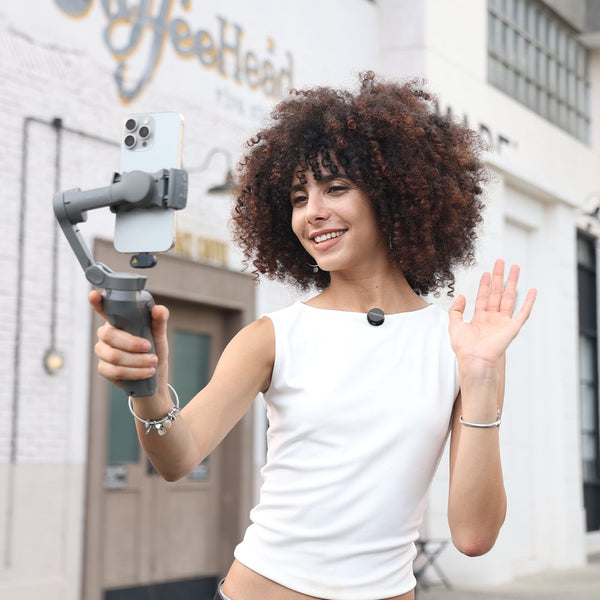Are you planning to host a webinar? You can create an ad and upload it across platforms like Facebook, TikTok, and more using a reliable wireless microphone to add credibility and sound professional. You can also use the wireless microphone with receiver and wireless microphone with transmitter throughout your training for consistent audio quality. Continue reading as we explore how AI can help freelancers deliver web design projects faster and how a wireless microphone or choosing the best wireless microphone for camera can help you increase traffic to your webinar registration.

Introduction: The Future of Branding and Creative Workflows
Artificial intelligence (AI) is no longer a futuristic concept—it’s here, shaping how designers, marketers, and businesses approach branding and web development. In the past, creating a strong brand identity or building a user-friendly website often took weeks or months of creative brainstorming, prototyping, and revisions. Today, AI is making those workflows faster, smarter, and more efficient without compromising creativity.
From AI-powered design assistants that generate logos in seconds to website builders that adapt layouts automatically, the landscape of branding and web design is transforming rapidly. Companies that embrace these tools are seeing dramatic improvements in delivery times, productivity, and client satisfaction. But how exactly does AI reshape creative workflows, and how can professionals use it without losing their human touch? Let’s dive in.
Web Design in 2025: Faster, Smarter, and More User-Centric with AI
Web design is moving toward a future where personalization and user experience (UX) dominate. By 2025, websites won’t just look attractive—they’ll respond intelligently to user needs. AI is already powering adaptive layouts, predictive UX flows, and accessibility improvements.
-
Smarter personalization: AI analyzes user behavior and tailors site layouts, colors, and calls-to-action (CTAs) for individual visitors.
-
Accessibility by default: AI tools can automatically add alt text, optimize color contrast, and ensure compliance with accessibility standards.
-
Speed and scalability: Platforms like Wix ADI and Framer AI allow designers to build functional, professional websites in hours instead of weeks.
For brands, this means delivering more user-focused websites with less manual effort—making the customer journey smoother and more engaging.
From Concept to Delivery: Cutting Project Timelines in Half with AI Tools
One of AI’s biggest advantages is how it accelerates the transition from idea to final delivery. What once required multiple iterations can now be streamlined:
-
AI brainstorming: Tools like ChatGPT or Jasper can generate branding concepts, taglines, and campaign ideas in minutes.
-
Instant mockups: Platforms like Canva’s AI and Figma’s design assistants create on-brand visuals faster than traditional manual methods.
-
Automated testing: AI-driven analytics can test different variations of design and copy, predicting which version performs best before launch.
Integrating AI into these early stages helps designers cut down on endless back-and-forth revisions. For agencies and freelancers, this translates into 50% faster delivery times without sacrificing quality.
How to Use AI for Smarter Client Collaboration in Branding & Design
AI also improves the often-overlooked side of design: collaboration with clients. Miscommunication is one of the leading causes of project delays, but AI tools are bridging the gap:
-
Real-time feedback loops: AI-enabled project management tools like Notion AI or Asana with smart integrations allow clients to review, comment, and approve designs more efficiently.
-
AI-driven visualization: Instead of explaining design concepts, designers can instantly generate multiple variations for clients to compare.
-
Language assistance: AI helps translate feedback across languages, eliminating misunderstandings in global projects.
This smarter collaboration not only saves time but also ensures clients feel more engaged and satisfied with the process.
Boosting Productivity: AI Hacks Every Designer Should Know
AI isn’t just about replacing tasks—it’s about amplifying human creativity. Here are some productivity hacks every branding and web designer should know:
-
Automated background removal – Tools like Remove.bg cut hours of photo editing.
-
Color palette generation – AI can instantly generate brand-specific palettes that fit industry trends.
-
Content drafting – Copywriting AI tools produce website text and ad copy tailored to target audiences.
-
SEO optimization – AI analyzes keywords and structures web pages for better search rankings.
-
Version control – AI tracks changes, helping teams avoid mistakes and keep projects aligned.
When used effectively, these hacks free up more time for the strategic and creative side of design.
Integrating AI into Your Design Process Without Losing Creativity
A common fear among creative professionals is that AI might replace originality. But the key is integration—not replacement. Designers who embrace AI as an assistant, not a substitute, can:
-
Use AI for repetitive tasks, freeing time for higher-level creativity.
-
Let AI generate multiple drafts, then refine them with a human touch.
-
Blend data-driven insights from AI with emotional, human-centered design thinking.
The best creative workflows in 2025 will be a hybrid model: AI handles the heavy lifting, while designers provide vision, strategy, and authenticity.
Why Audio Matters: Delivering Your Webinar with a Wireless Microphone
While design and branding take center stage, how you present your expertise matters just as much. For professionals delivering webinars, workshops, or client presentations, audio quality is critical. Poor sound can distract from your message and reduce audience engagement—even if your content is excellent.
This is where a wireless professional microphone system becomes an essential tool:
-
Mobility: Move freely during presentations without being tethered to your desk.
-
Clarity: Wireless mic setups with a wireless microphone with receiver ensure stable connections, while a wireless microphone with transmitter lets you move around without losing signal.
-
Professional impression: Whether you’re recording video, giving talks, or singing, the right mic setup—from the best wireless microphone for camera recording to the best wireless microphone for live vocals—adds authority and polish.
Recommended options include the Maono Wave T5 wireless microphone for professional-grade clarity and the Maono Wave T1 Mini wireless microphone for a compact, beginner-friendly solution. Using the right audio setup ensures your webinar on AI in branding leaves a lasting impression.
FAQ Section
Q1: How can AI help create a consistent brand identity across platforms?
AI tools analyze logos, fonts, and color schemes to ensure consistency across social media, websites, and marketing materials.
Q2: Can AI generate brand guidelines or do designers still need to create them?
AI can draft guidelines, but human designers refine them to align with brand values and vision.
Q3: What are the best AI tools for developing logos and visual assets?
Looka, Canva AI, and Logo AI are popular choices for quick, customizable brand visuals.
Q4: How do I ensure AI-generated branding still feels authentic and human?
Always combine AI outputs with human creativity—refine tone, add storytelling, and emphasize emotional connection.
Q5: Which AI tools are most effective for building modern websites quickly?
Wix ADI, Framer AI, and Durable AI are leading platforms for rapid, AI-powered web design.
Q6: How do AI website builders compare to traditional coding or WordPress?
AI builders are faster but less customizable; WordPress and coding still offer deeper control.
Q7: Can AI help improve user experience (UX) in web design?
Yes—AI analyzes behavior patterns to create intuitive layouts, navigation, and CTAs.
Q8: What role will AI play in responsive design and accessibility in 2025?
AI will automate accessibility features and optimize designs for multiple devices.
Q9: How can AI automate repetitive design and project management tasks?
It can generate drafts, organize timelines, and handle client communications.
Q10: Can AI cut down client revision cycles in branding and design projects?
Yes, AI generates multiple design options upfront, reducing the need for endless revisions.
Q11: How much faster can projects really be delivered using AI tools?
Projects can be completed up to 50% faster, depending on complexity.
Q12: What are the risks of relying too much on AI for design delivery?
Over-reliance can lead to generic results and lack of originality. Balance is key.
Q13: Why should I use a wireless microphone for my online presentations?
Wireless mics provide better sound quality and allow free movement.
Q14: What’s the difference between a wired and wireless mic for webinars?
Wired mics restrict movement, while wireless mics offer flexibility and mobility.
Q15: How does audio quality impact engagement in online webinars?
Clear audio keeps audiences attentive; poor audio leads to drop-offs.
Q16: What are the best wireless microphones for professional webinar hosting?
The Maono Wave T5 for advanced users and Maono Wave T1 Mini for beginners are excellent picks.
Q17: Will clients accept AI-generated work as professional-grade design?
Yes, when refined by human expertise. AI provides speed, but humans add value.
Q18: How can AI help freelance designers compete with bigger agencies?
AI levels the playing field by giving freelancers access to faster, high-quality tools.
Q19: Can AI-powered workflows reduce costs while improving project quality?
Yes, by cutting labor time and streamlining revisions, reducing overall expenses.
Q20: How can branding professionals balance speed and creativity with AI?
Use AI for execution and data-driven tasks, while reserving creativity for human input.

Conclusion
AI in branding and web design isn’t about replacing human creativity—it’s about augmenting it. From accelerating web design to simplifying client collaboration, AI is helping designers deliver faster, smarter, and more user-focused results. The professionals who thrive in this new era will be those who embrace AI as a partner while keeping their unique creative perspective.
And when it comes to sharing this knowledge through webinars or client presentations, don’t forget the power of clear audio. With tools like the Maono Wave T5 or Wave T1 Mini wireless microphone, your voice can match the clarity and professionalism of your AI-powered design workflow.
The future is here—smarter design, faster delivery, and creativity that shines brighter when supported by AI.



